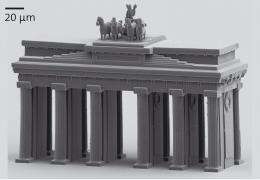December 16, 2010 feature
Using direct laser writing to create 3D submicron structures

(PhysOrg.com) -- "Several groups have been using direct laser writing since the end of the 1990s," Michael Thiel tells PhysOrg.com. Thiel is a scientist has been working at the Karlsruhe Institute of Technology (KIT) in Germany. "Direct laser writing has evolved rapidly, and direct laser writing is used in lithography. The group I have been working with has made even more improvements, and the technique we have developed is so successful that we spun off a company, Nanoscribe, which is located in an incubation facility on campus."
The technique that Thiel refers to is one that involves using direct laser writing with a continuous-wave laser to create three dimensional submicron structures. This technique has the potential to be useful in a number of fields, and it offers opportunities to enhance lithography. Thiel and his colleagues, Fischer, von Freymann and Wegener, describe the experiments used to test their state-of-the-art technique in Applied Physics Letters: “Direct laser writing of three-dimensional submicron structures using a continuous-wave laser at 532 nm.”
“We are already quite used to seeing lithography in two dimensions,” Thiel says. “Our new technique allows patterning in three dimensions. We use a very local writing tip that exposes only one spot, and that allows us to pattern in 3D.”
In order to get this very local writing tip, Thiel and his fellow team members concentrated photons from a laser onto a photo-sensitive material. The tips can be directed by a computer, so it is possible to program the pattern on the computer, and then use the laser to create what has been programmed. “You pattern whatever you want,” Thiel says. “There are a number of possibilities.”
One of the things that makes the patterning technique developed at the Karlsruhe Institute of Technology so unique is that a continuous-wave laser is used. When most scientists think of direct laser writing, they think of focused, mode-locked femtosecond laser pulses. “The continuous-wave laser makes it easier to produce for industry,” Thiel explains. “We wanted to show that you could still do direct laser writing with a continuous-wave laser, and we have shown that it is possible to get state-of-the-art results when using our technique to create submicron structures.”
A continuous-wave laser is easier to direct, and it is less expensive than the femtosecond lasers used in the past. This, combined with the fact that Thiel and his colleagues were careful to demonstrate their technique using commercially available photoresists, creates a situation in which lithography for a variety of applications becomes possible.
“There are several applications for direct laser writing,” Thiel points out. “Some of the customers who have bought our systems from Nanoscribe have used them to produce cloaking devices, and others have created metamaterials. There are applications in photonics, cell biology or microfluidics.”
Thiel maintains that the ideal is to continue to improve the system so that the technique can become more widely available. “We are working to get the technique for direct writing of 3D structures up to the industrial standard for lithography,” he says. “Our system should be very easy for the customer to use, and it offers a number of opportunities for future applications.”
“This 3D microworld is very fascinating,” Thiel continues. “And it’s no longer just a laboratory curiosity. You can use our technique to make a design file from your computer into a real structure.”
More information: M. Thiel, J. Fischer, G. von Freymann, and M. Wegener, “Direct laser writing of three-dimensional submicron structures using a continuous-wave laser at 532 nm,” Applied Physics Letters (2010). Available online: link.aip.org/link/APPLAB/v97/i22/p221102/s1
Copyright 2010 PhysOrg.com.
All rights reserved. This material may not be published, broadcast, rewritten or redistributed in whole or part without the express written permission of PhysOrg.com.


















